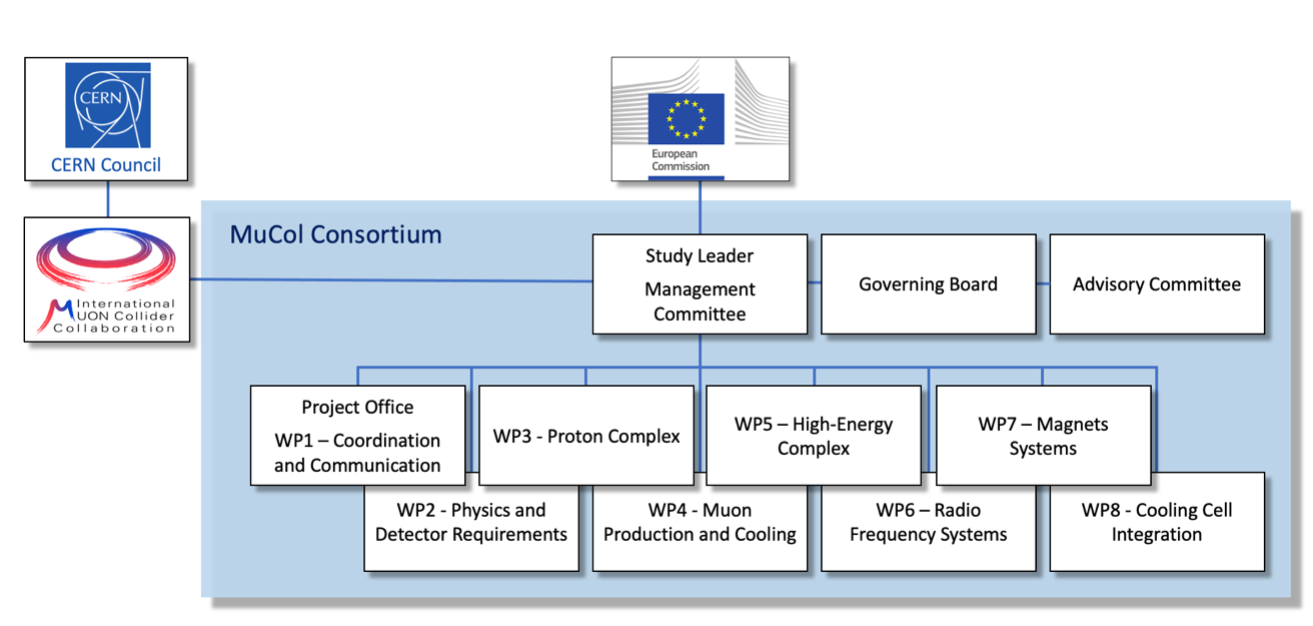PROGRAMME: Horizon Europe Framework Programme (HORIZON)
DURATION: March 2023 - February 2027
CONSORTIUM: 32 Participants from 10 countries
PROJECT COORDINATOR: Daniel SCHULTE (CERN)
PROJECT TECHNICAL COORDINATOR:Roberto LOSITO (CERN)
The project
Muon colliders can reach centre-of-mass energies of tens of TeV with high luminosity. Muons are point-like particles, so the entire beam energy is available to produce short-distance reactions, which allows direct searches for new particles over a wide range of unexplored masses. A muon collider also allows accurate tests of the Standard Model at extremely high energy, offering opportunities to detect new physics indirectly and to confirm and to characterise direct discoveries. By exploiting the copious rate for vector boson fusion and vector boson scattering processes, the muon collider provides the opportunity to probe the finest details of the electroweak symmetry breaking mechanism.
A number of technical challenges must be overcome in order to realise the muon collider. The EU has supported the MuCol programme to address the core of these key challenges. MuCol will develop the collider concept and assess the physics performance based on realistic performance goals for the collider components. The identification of the cost and power consumption drivers will enable determination of the cost and power consumption scale. This will allow the next European Strategy for Particle Physics Update (ESPPU) process to make informed choices for the selection of the next large collider to be built in Europe.
The MuCol study will produce a coherent description of a novel particle accelerator complex that will collide muons of opposite charge at the energy frontier. The study will target a centre-of-mass energy (ECM) of 10 TeV with 3 TeV envisaged as a first stage. MuCol will address the design of the Muon Collider facility using a holistic approach, from muon generation to collision, including the study of the interaction regions and the background to the experimental detectors, and will explore the associated technologies. The final report will include a thorough assessment of benefits and risks of the accelerator and detector complex, including an evaluation of the scientific, industrial and societal return beyond high-energy physics, the cost scale and sustainability of the complex and the impact arising from an implementation on the CERN site.
The structure of the project
Organisation of MuCol

Schematic diagram of interactions among workpackages:

What are the MuCol objectives ?
The main outcome of MuCol will be a report documenting the facility design that should demonstrate that:
-
the physics case of the muon collider is sound and detector systems can yield sufficient resolution and rejection of backgrounds;
-
there are no principle technology showstoppers that will prevent the achievement of a satisfactory performance from the accelerator or from the detectors side;
-
the muon collider provides a highly sustainable energy frontier facility as compared to other equivalent colliders;
-
exploiting synergies with other scientific and industrial R&D projects, it is a valuable platform to provide Europe a leading edge not only in terms of discovery potential, but also for the development of associated technologies.
Who are the organisations behind MuCol ?
The consortium comprises 32 Institutes out of which 12 are Beneficiaries and 20 Associates. The idea to setup a European Project to perform a design study of a Muon Collider has raised a lot of interest in several scientific communities, and the Consortium that has been setup has already reached the goal of enlarging the scope of the Muon Collider Collaboration to new Institutes and different fields of science.
The Consortium will comprise in fact Laboratories and Universities from the following fields:
• High Energy Physics
• Accelerator Physics
• Spallation Neutron Sources
• Fission/fusion nuclear technologies
• High Field Magnets for medical applications and material studies.
CERN will coordinate the project, in line with its mandate to coordinate at European level the efforts of R&D in accelerator physics and Technology.
The Consortium will comprise a balanced mix of Laboratories, some of them with specific competencies, and others with a vast experience and spectrum of competences in Accelerator physics and technology. The Consortium is complemented with Universities, that will provide the link to academia and will bridge the gap towards young generation of researchers, providing opportunities for direct dissemination through public lectures and seminars, and high level scientific support to the studies in MuCol, as well as a platform to hire the required PhD students and PostDocs.
You can find the complete list of participating institutes in the dedicated page.
